Swedish Immigration Paintings by Alison Aune

(©Alison Aune, acrylic on canvas, 11 1/2” x 19” 2020)
History: My Great Grandmother’s father Johan (John) Petter Andersson left Sweden, like 1.2 million other Swedes, to come to America in the 19th century. He was the third of twelve children and when he was 21 years old, he left Ormeshaga Norregård, Hovmantorp in Småland to join his brother Carl (Charles) Vitalias in Chisago County, Minnesota in 1869.Johan worked on the railroad and then as a lumberjack before marrying Ingrid (Olsdotter) Olsson, also a native of Sweden, to start their family in Franconia, near Shafer, in 1875. At one point, Johan changed his last name from Andersson to Vitalis, his brother’s middle name, and two more brothers from Sweden joined them. Johan became a successful farmer with 166 acres of farmland and was a community leader.
Johan and Ingrid had nine children: Walter, Mary, Alphonse, Ida, Andrew, Otto, Alice, Emma, and my Great Grandmother Hulda. Hulda would grow up and marry August Johnson, born in Sweden, and they raised their three children, Rudolf, Leila, and my Grandmother Iva in Almelund, Minnesota.
When Iva was 22 years old, she left the farm to work as a domestic worker in Minneapolis where she met her husband Joe Carlson, also Swedish-American, and they had three children: my Uncle Phil, Aunt Nila, and my Mother Ilene.
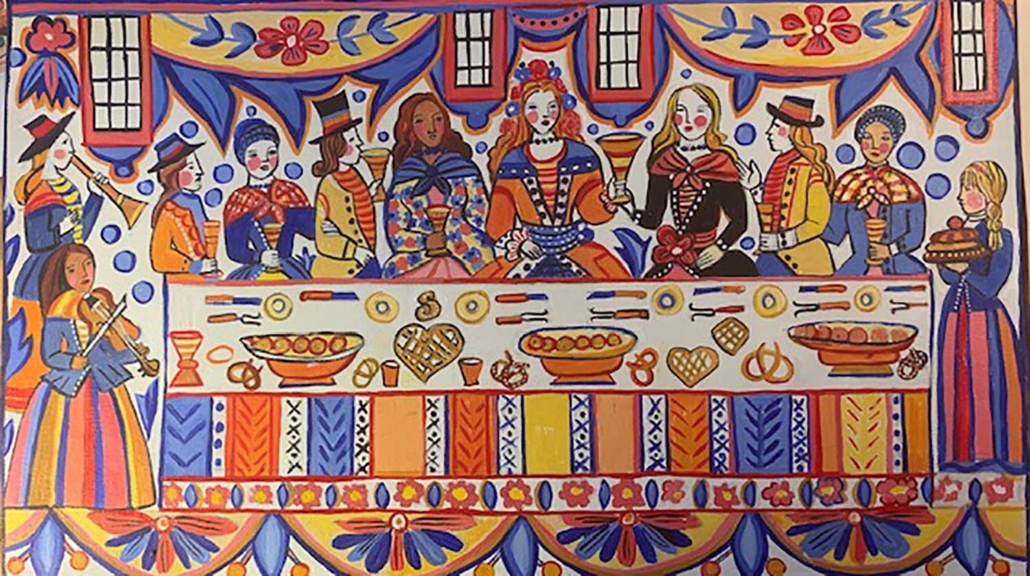 (©Alison Aune, Fest, acrylic on canvas, 8 1⁄2” x 28 1⁄2” 2020)
(©Alison Aune, Fest, acrylic on canvas, 8 1⁄2” x 28 1⁄2” 2020)
My Mother left Minnesota with my Norwegian-English-Minnesotan father, Dr. Bruce Aune to raise three daughters, me, Patty, and Kirsten, in Amherst, Massachusetts where my Father was a professor of philosophy at the University of Massachusetts. My Mother, like many others of her generation, did not learn to speak Swedish but she preserved cultural traditions through food, textiles, and folk art. I still have, and treasure, her Dalahäst, Swedish smörgåsbord tablecloth, Berggren Trayner Var Så God ceramic cups, Var Så God: Heritage and Favorite Recipes & Handbook of Swedish Traditions cookbook from the American Swedish Institute and her books on Swedish Folk painting.
Growing up in Massachusetts I did not think too much about my Scandinavian ancestry except at Christmas when we opened presents on Christmas Eve, which is the right way of course, and we ate rice pudding, rutabegas (known as Swedes in England!) and Swedish meatballs! It was during the winter and summer holidays when we visited relatives in Minnesota that I would hear Swedish being spoken by my Grandma Iva and Great Grandma Hulda.
I did not understand why they spoke that way and I never asked my parents about it. I also thought that the women’s names were different from the ones I knew in New England: Nila, Leila, Iva, Emma, Ida, and Hulda! I did know that our Swedish heritage was a central aspect of my Grandmother Iva’s life. She worked as a cook at the Swedish Hospital and was a highly skilled tailor and seamstress, raising three children alone after the early death of her husband when my mother was 6 years old. Grandma Iva took us to Swedish stores on Lake Street, visits to the American Swedish Institute and most of all, she created the most amazing smörgåsbords. When I was 10 years old, I remember seeing the movie of Vilhelm Moberg’s The Emigrants on TV with Max von Sydow and Liv Ullman and my Dad told me that was like my mother’s family story. I was beginning to understand and appreciate some of my mother’s heritage.
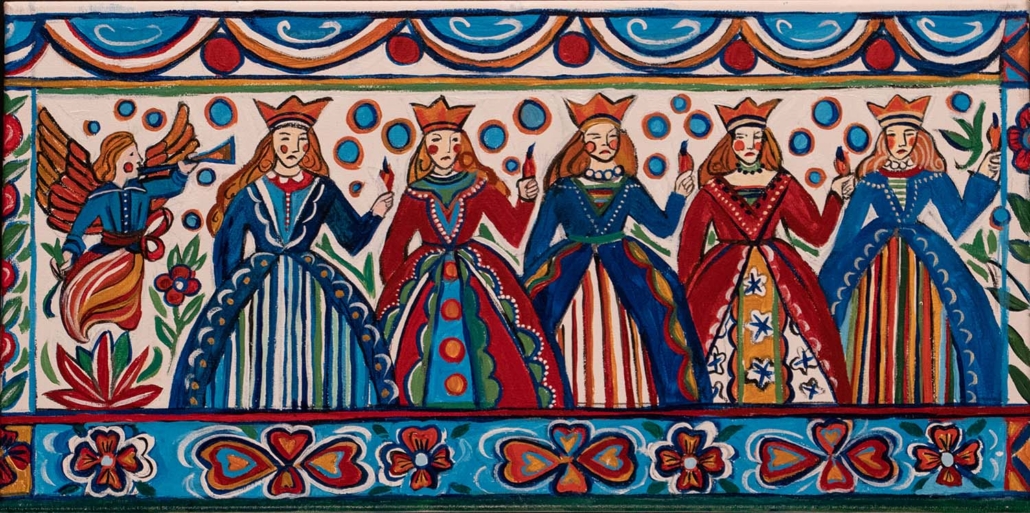
(©Alison Aune, acrylic on canvas, 8” x 28” 2020)
However, during my later teen years of the 1970s, I rejected the Swedish textile heritage of my maternal ancestors and even told my mother that I ‘hated Swedish folk art.” How could I have said that?
Today I am heartbroken by this! It was during that time that my Great Grandmother Hulda and Grandmother Iva passed away. They did not live to know that I would spend my junior year of college as an art student at Östra Grevie Folkhögskola in Skåne, Sweden and that I would learn Swedish and continue to return to Sweden as a researcher, artist, and Fulbright Scholar! They did not know that after college on the East Coast and working on the West Coast, that I would come to Minnesota for graduate school and settle here or that I met my husband Jon Hinkel here and we named our Minnesota-born children Leif, Kjell, and Linnea! In 2009, Kjell and Linnea even spent a semester with me in Växjö!
As a grandmother myself now, I have shared my Swedish traditions with the next generation through food, textiles, folk art, stories, and by participating in Lucia and Midsommar festivities in Duluth!
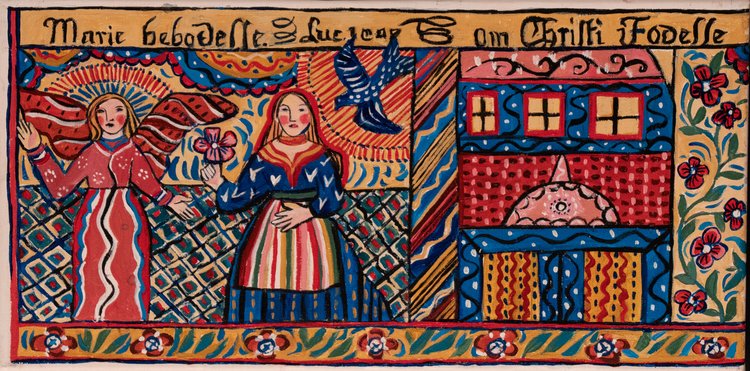
(detail: ©Alison Aune, Swedish Christmas, acrylic on canvas,10” x 40” 2019)
Here I will share the story of my Immigration Paintings!
In 1997, I became a member of the Swedish Cultural Society of Duluth and I began painting Swedish-inspired images to honor the memory of my mother Ilene (Carlson) Aune, who had passed away in 1994, and to pay tribute to my Grandmother and Great Grandmother. I began to create Swedish folk-inspired paintings for the Swedish Cultural Society of Duluth for their brochure covers, booklets, cards, tiles, nametags, and posters for Santa Lucia, Midsommar, and for special programming.
During our cultural events, I taught Dalahäst painting, Majstång making and Bloomakronor (flower crown) workshops for all ages and created a children’s Midsommar coloring-songbook. I continue to do this today. In 2007, I began to focus on Nordic textile inspired motifs in my mixed media paintings as a tribute to my Nordic heritage and to all the “artists in aprons,” the women who preserved Swedish culture through their textile designs and handwork.
It has been a great honor that these paintings have been exhibited in Sweden and at such venues as the Scandinavian Cultural Center at Pacific Lutheran University in Tacoma, WA, and with my sister Kirsten at the Vesterheim Museum in Decorah, IA, Norway House and
the American Swedish Institute in Minneapolis, and at the Swedish American Museum in Chicago, IL (https://news.d.umn.edu/news-and-events/news/alison-aune-2020).

(©Alison Aune, Swedish Wise and Foolish Virgins, acrylic on canvas, 2020)
Swedish Folk Painting: Three years ago, I took my first Swedish folk painting classes at the North House Folk School in Grand Marias with folk painter Pam Rucinksi and then with author and painter Diane Edwards. Last year, I studied with folk painter Pieper Fleck Bloomquist at the American Swedish Institute and with support from the American-Scandinavian Foundation Folk Arts Grant I studied with Judith Etzold at the Museum of Swedish Folk Art at Unnaryd– Jälluntofta Hembygdsförening Bonadsmuseum, Åse Larsjos of Dalafolk Art and Pernilla Nordstrom of Kurbits Studio in Falun, Sweden.
In October 2019, I exhibited my new folk paintings with folk artists Judith Kjenstad and Pieper Fleck Bloomquist in an exhibition called Swedish Folk Painting: Revival in the Upper Midwest at the Nordic Center in Duluth. We are hopeful that this exhibition will travel to other venues and I am honored to keep, and share, the tradition of Swedish folk painting alive!
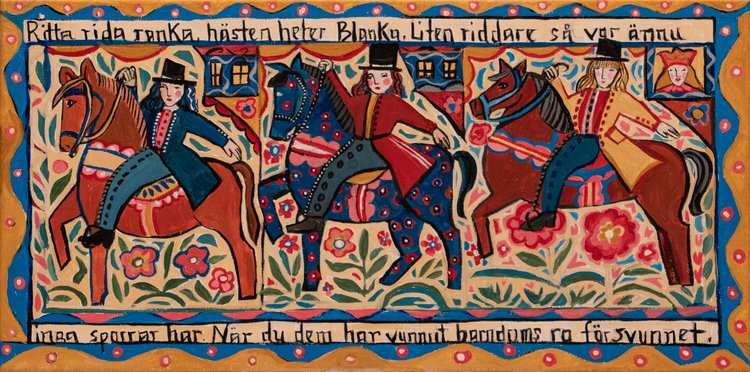
(©Alison Aune Swedish Horses, acrylic on canvas 10” x 20” 2019)

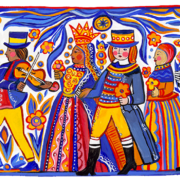
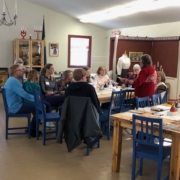

Mycket roligt att läsa om din bakgrund och din konst. Lycka till med dina utställningar efter Corona.
Jag svarar på svenska då jag känner så mycket för dina alster. De tryck som du har gjort känner jag så långt inne i min själ. Du är så duktig. Hoppas du fortsätter att berika människor med det du gör. Så Bra!
Kenneth Janermark
Wonderful article and beautiful examples of your art! You are remarkable. So happy we had the chance to travel to Vaxjo in 2017 with Anne and the Sister Cities delegation. Hope to see you in person soon.